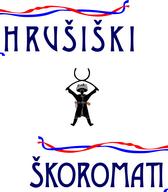Škoromatija: carnival tradition in Hrušica (Brkini)
Škoromatija is a carnival tradition on the southern edge of the Brkini. On Carnival Saturday škoromati in village Hrušica go around the houses collecting gifts and on Ash Wednesday they bury or burn Shrovetide.
The exhibition ŠKOROMATIJA: carnival tradition in Hrušica (Brkini) presents 4 old carnival figures from 1962 and 5 contemporary carnival figures (ŠKOROMAT WITH BELLS, KLEŠČAR or ŠKOPIT, POBERIN (COLLECTOR), PEPELJUHAR (ASHMAN), CUNJAR (RAGMAN)). Other figures as TURK, BRIDE AND GROOM, MARKO THE BEAR AND MASTER, THE FAT ONE, GYSPY MAN AND WOMAN, THE GREEN ONES, MUSIC, CHIMNEY SWEEP, FORESTER, that are part of škoromatija are presented with photographs and with video.
About Škoromatija:
Today Škoromati Shrovetide carnival masks can be seen on the southern edge of the Brkini and in the Podgrajsko-Matarsko podolje area in the villages of: Hrušica, Gradišče, Ritomeče, Obrov, Javorje, Male Loče, Podgrad, Podbeže and Račice. In Hrušica some carnival figures wear face masks, in other villages they paint their faces. Carnival outfits are made by the young men themselves, with the help of mothers and girlfriends. Since 2012 the Škoromatija as a carnival custom has been included in the Register of Intangible Cultural Heritage.
On St Stephen's Day (26 December) men and boys gather, roles are distributed and the organisation of the Škoromatija is agreed. The main event involves collecting around local villages, which in Hrušica takes place on Shrove Saturday: they gather in the middle of the village and then set off on their tour. The Poberina (collectors) and the Škoromat with bells separate from the main group and go from house to house collecting gifts. They enter the houses uncovered, so that the householders know who has come, and they ask if they have anything for the Škoromati; then they thank them for the presents, wish them all the best for the coming year and take their leave. Meanwhile, the main group goes through the village acting the fool, stopping at houses, making merry, dancing with local woman, and eating and drinking what the villagers have prepared for them. On Ash Wednesday the carnival figure of Pust is taken to the edge of the village and burned.
The first mention which the Škoromati cite for their custom is in the archive records of Cividale and Udine in Friuli (Italy), where in 1340 it was forbidden to appear in a scaramatte outfit at Shrovetide. The source of the word scaramatte, sgaravatte, is thought to derive from the German word Scharwächter, which means 'company guard'. The most direct typological characteristics of the scaramatte are preserved in the carnival figure Kleščar. The collective name Škoromati was preserved for carnival figures in the Brkini area. The first known record of Škoromati and the Škoromatija is from 1952.
Author of the exhibition: mag. Adela Pukl, SEM





